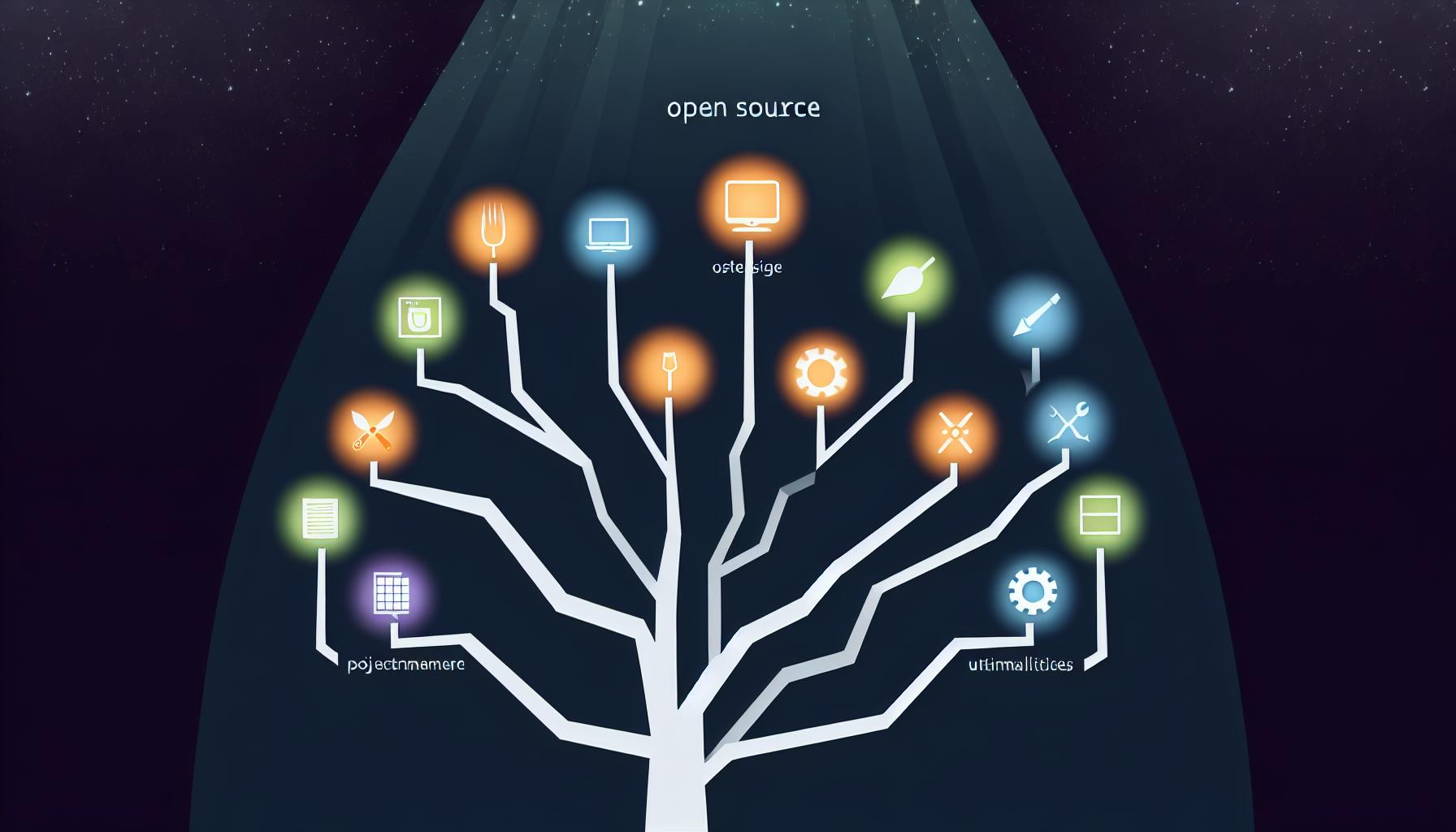Selecting an open source collaboration platform can be overwhelming given the many options available.
In this post, I'll walk you through the key criteria to consider when choosing an open source platform that aligns with your team's needs for scalability, security, and usability.
You'll learn the strengths of popular platforms like Nextcloud, Rocket.Chat, BigBlueButton, and OpenProject. I'll also provide recommendations on deciding between self-hosted vs SaaS, evaluating customization vs out-of-the-box ease of use, and ensuring adoption across your organization.
Introduction to Open Source Collaboration Platforms
Open source collaboration platforms provide a way for remote teams to communicate and collaborate effectively on projects. Unlike proprietary software, open source platforms give users full control and customizability without licensing fees. As remote work becomes more common, choosing the right open source tools is key for productivity.
When evaluating collaboration platforms, consider features, scalability, governance, and integration capabilities. This article outlines the benefits of open source options and essential criteria to help teams select the best software for their needs.
Understanding Open Source Collaboration Meaning
Open source collaboration platforms are tools that enable real-time communication, content collaboration, and project management capabilities for remote teams. They are built on open source code that users can view, modify, and distribute.
Common features include:
- Instant messaging
- Video/voice conferencing
- File sharing
- Collaborative document editing
- Task management
- Custom workflows
Enabling remote teams to message, meet, co-author files, manage projects, and more in one platform improves productivity through seamless collaboration.
Advantages of a Free Open Source Collaboration Platform
Choosing open source collaboration software over proprietary options offers teams several advantages:
- Cost: Open source platforms can be self-hosted for free or have much lower licensing fees
- Customizability: Ability to modify platform code and integrate with other tools
- Security: Public code auditing improves vulnerability detection
- Community: Open source projects have user forums and developer teams to provide support
Open source gives teams more control, flexibility, and ownership over their collaboration environment.
Essential Selection Criteria for Collaboration Software
When evaluating open source collaboration platforms, consider these key criteria:
Features: Ensure core communication and collaboration features fit team needs. Evaluate integrations, governance, and customization capabilities.
Scalability: Can the platform easily scale from small to large teams while maintaining performance?
Governance: Does it have permissions settings for access control and data ownership?
Integration: How easy is it to integrate with existing tools like single sign-on, calendars, and workflows?
Carefully weighing these criteria helps match the right software to a team's specific use case, future growth, and stack compatibility.
What is an open source collaboration?
An open source collaboration platform enables developers, teams, and organizations to work together on software projects in an open and transparent manner.
At its core, open source collaboration facilitates:
- Access to source code so it can be inspected, modified, and redistributed
- Decentralized and distributed development across timezones
- Community-driven development and peer review
Rather than siloed proprietary software restricted to specific users, open source projects are open to contribution from anyone. They tap into the collective intelligence of a global developer community.
Open platforms make it easy to manage workflows like:
- Code hosting and version control
- Issue tracking
- Project planning
- Code reviews and approvals
- Communication and notifications
Leading examples include GitHub, GitLab, Bitbucket, and SourceForge.
Benefits include lower costs, better security, flexible customization, and shared innovation. Teams can build upon existing open source work rather than reinventing the wheel.
For these reasons, open source collaboration is hugely popular for software development. Over 80% of companies now leverage open source code in their tech stack.
What are the 3 types of collaboration software?
When evaluating collaboration platforms, it's helpful to understand the main categories:
Communication Software
This type focuses on enabling communication between team members through:
- Instant messaging
- Audio/video calls
- Screen sharing
Popular open source options include Rocket.Chat and Mattermost.
Conferencing Software
Main features include:
- Scheduling and hosting meetings
- Presentation capabilities
- Recording sessions
Open source choices like BigBlueButton and Jitsi Meet offer robust conferencing tools.
Project Management Software
Key capabilities involve:
- Task management
- File sharing
- Project tracking
OpenProject and Taiga provide open source project coordination with Kanban boards, Gantt charts, etc.
So in summary, think about your team's needs - frequent messaging, meetings, or project management. Then match those collaboration requirements to the right category of software. Leading open source platforms in each space provide a solid foundation.
What is the best online collaborative tool?
Open source collaboration platforms provide teams with secure spaces to communicate, collaborate on projects, and manage workflows. With so many options available, it can be challenging to determine the best fit for your needs. Here are some top open source collaboration tools to consider:
Switchboard
An excellent overall team collaboration tool. Key features include:
- Team messaging with threaded conversations
- File sharing and cloud storage integration
- Video calls and screen sharing
- Kanban boards for task management
- Customizable workflows
Switchboard is self-hosted, allowing you to retain control over data and security. The intuitive interface makes it easy for teams to adopt.
Nextcloud
A popular self-hosted content collaboration platform. Offers:
- Document editing and sharing
- Calendar and contacts syncing
- Audio/video calls
- Password-protected file shares
- 100+ apps to extend functionality
Nextcloud enables teams to consolidate many collaboration tools under one platform. It can replace services like Dropbox, Google Drive, Office 365 while maintaining data ownership.
Rocket.Chat
Leading open source team chat software. Notable capabilities:
- Instant messaging with emoji reactions
- Voice and video conferencing
- Screen sharing sessions
- Custom bots and integrations
- On-premise or cloud hosting
Rocket.Chat facilitates casual team discussions alongside structured workflows. The system is highly customizable to a team's communication needs.
Evaluating collaboration tools requires balancing features, flexibility, and cost. Open source options empower teams to create tailored solutions adapted to their unique working culture.
sbb-itb-9c854a5
What is an example of a collaboration platform?
Telegram is a great example of an open source collaboration platform. As a cloud-based instant messaging and voice over IP service, Telegram offers robust collaboration features, end-to-end encrypted messaging, open API and protocol free for everyone.
Some key features that make Telegram an effective collaboration platform include:
- Group Chats - Telegram supports group chats for up to 200,000 members. This makes it easy to communicate and collaborate across large teams or communities.
- File Sharing - You can easily send and receive documents, photos, videos, audio files and more up to 2GB in size in private or group conversations.
- Bots & Tools - Telegram has a wide range of open source bots and tools to improve productivity such as @VoteBot for polls, @Like bot to add reactions and more. Developers can build custom tools.
- Security - Telegram uses client-server encryption for private chats and secret chats. All data is encrypted in transit and at rest.
For design teams, Telegram provides an excellent platform for collaborating on mockups, exchanging feedback, coordinating tasks and sharing inspiration. The ability to add visuals combined with fast, secure messaging helps streamline communication.
As an open platform with a free API, Telegram makes it easy for developers to integrate new tools and bots for even more robust collaboration. For open source projects or communities, Telegram can provide a unified hub for discussion, support and organizing collective efforts.
With flexible group administration, security, cloud sync and broad platform support, Telegram serves as a full-featured, open source alternative to closed collaboration platforms for teams of all sizes.
Exploring Open Source Collaboration Platform Examples
Open source collaboration platforms provide teams with secure spaces to communicate, collaborate on documents and projects, and manage workflows. As open source software, these platforms offer flexibility, customizability, and no vendor lock-in.
When evaluating collaboration solutions, key aspects to consider include:
Nextcloud: A Comprehensive Cloud Collaboration Suite
Nextcloud offers an extensive set of collaboration features built on top of its secure file hosting and syncing capabilities:
- Real-time document editing with Collabora Online
- Calendar, contacts, mail clients
- Audio/video chat powered by Spreed server
- Project management integrations like OpenProject
- Customizable dashboards and workflows
- Self-hosted option with full data ownership
With its modular architecture, admins can enable only the apps needed. The open source model provides transparency and control over the platform.
Rocket.Chat: Instant Messaging Solution for Teams
Rocket.Chat focuses on team chat with additional capabilities:
- Channels, direct messages, and group messages
- Audio/video conferencing
- Screen and file sharing
- Guest access and federation between servers
- Bots and integrations with common apps
- On-premise, cloud, or hybrid hosting options
Rocket.Chat suits teams needing a customizable, secure alternative to services like Slack or Microsoft Teams.
BigBlueButton: Open Source Video Conferencing and Classroom
BigBlueButton targets education and virtual workshops with features like:
- Real-time screen sharing and annotation
- Collaborative whiteboard and slide editing
- Breakout rooms for small group discussions
- Polls, emojis, hand raise notifications
- Video recording and playback
Its specialized capabilities make BigBlueButton suitable for holding online classes, meetings, or webinars.
OpenProject: Project Management and Team Collaboration
OpenProject combines project planning with team collaboration:
- Tasks, time tracking, roadmaps
- Document management with version control
- Meeting coordination and notes
- Custom fields and open API for integration
- Community and enterprise hosting options
For technology and development teams, OpenProject can centralize communication and task management.
Evaluating collaboration needs and platform capabilities is key to finding the right open source fit. The flexibility of these solutions allows customization for an organization's specific use cases.
Assessing the Best Open Source Collaboration Platform for Your Needs
Choosing the right open source collaboration platform can be challenging with so many options available. Here are some key factors to consider when evaluating platforms:
Scalability for Growing Teams and Projects
- Support for larger numbers of users, teams, and projects as your needs expand over time
- Flexible permission schemes to manage access
- Options for integrating with existing infrastructure and workflows
Usability vs Customization: Striking the Right Balance
- Ease of use for new users while still allowing customization
- User experience right out of the box vs setup time required
- Evaluating if customization is worth the additional effort
Choosing Between Self-Hosted and SaaS Collaboration Platforms
- Control over data and infrastructure with self-hosted
- Potentially higher maintenance with self-hosted
- Subscription costs with SaaS models
Ensuring Security and Compliance in Collaboration Tools
- Review security features like encryption, access controls
- Assess compliance with regulations like HIPAA, GDPR
- Understand where data is stored and accessed
Carefully evaluating collaboration platforms against your current and future needs can ensure you select the right open source option for your team. Prioritizing scalability, usability, deployment method, security, and compliance will lead to the best long-term solution.
Implementing Your Chosen Open Source Collaboration Software
The Self-Hosting Advantage in Open Source Collaboration Software
Self-hosting an open source collaboration platform provides several key advantages:
- Data sovereignty and privacy: When self-hosted, all data resides within your own infrastructure. This allows full control and oversight of sensitive information.
- Customization and flexibility: Open source platforms that you host allow unlimited customization to match unique needs. You can modify the codebase and integrate with other internal systems as required.
- Cost savings: Avoiding proprietary SaaS fees for collaboration tools can provide substantial long-term cost savings, especially for larger teams. The expenses of self-hosted infrastructure are relatively minimal.
Popular self-hosted collaboration platforms like Nextcloud, Rocket.Chat, and BigBlueButton give teams the flexibility to deploy open source Slack and Office alternatives on their own servers.
Integrating Open Source Alternatives to Slack and Other Tools
Integrating open source collaboration tools aims to improve productivity through:
- Unified platforms instead of disjointed apps
- Real-time communication and transparency
- Access to full archives and searchability
For example, Rocket.Chat provides persistent chat history, audio/video chat, screen sharing, and file management -- eliminating the need for separate tools.
Nextcloud, OwnCloud, and Pydio offer open source alternatives to Dropbox, Google Drive, SharePoint and other proprietary file sharing platforms. They enable:
- Company-controlled file sharing
- Integration with existing storage infrastructure
- Robust access controls and permissions
Collaborative Editing and Real-Time Communication Features
Modern teams require platforms with:
- Real-time co-editing for documents, spreadsheets, presentations, and code
- Unified communications for messaging, audio/video meetings, and webinars
- Shared whiteboards and diagrams for design collaboration
Open source options provide these features without restrictions, vendor lock-in, or per user fees.
For example, Nextcloud and OnlyOffice offer real-time collaborative editing of Office documents. BigBlueButton enables webinars, shared whiteboards, and screen sharing. OpenProject provides agile project management tools like Kanban boards.
Ensuring Usability and Adoption Among Team Members
To drive adoption of self-hosted open source collaboration platforms:
- Prioritize simplicity and ease-of-use
- Offer self-service onboarding resources
- Highlight benefits over existing tools
- Incentivize usage and participation
Gamification elements like contribution leaderboards and reward programs can further encourage engagement.
Focusing on strong usability and internal marketing is key to ensuring maximum value.
Conclusion and Actionable Recommendations
Final Thoughts on Choosing the Right Open Source Collaboration Platform
When selecting an open source collaboration platform, it's important to carefully evaluate your team's unique needs and priorities. Consider factors like the size of your team, the types of projects you work on, your security and compliance requirements, and your budget.
The platform you choose should align well with your use cases around messaging, document sharing, project management, meetings, and more. An extensible platform built on open standards can also allow you to customize and integrate with other tools down the road.
Ultimately, there is no one-size-fits-all solution. Taking the time upfront to properly assess your requirements and match them to platform capabilities will pay dividends with smoother adoption and long-term success.
Recommendations for Long-Term Success with Collaboration Software
To ensure your open source collaboration platform delivers lasting value, focus on three key areas:
- Thorough training and onboarding. Set aside adequate resources for training end users on the platform's core features and how best to leverage them for their daily tasks. Provide self-help documentation and quick start guides as handy references.
- Ongoing platform management. Designate platform administrators to handle user provisioning, security, integrations, customizations, and monitoring usage and performance over time. Keep the software updated and plan for future growth.
- User feedback collection. Regularly collect feedback from end users to identify areas for improvement. Use this input to expand features and functionality via extensions and custom solutions.
Next Steps: From Selection to Implementation
Once you've selected an open source platform for your team's needs, follow these recommended next steps:
- Install and configure the software based on best practices for your infrastructure. Perform testing before rollout.
- Develop a customized onboarding and training plan for your organizational context.
- Plan your pilot group, rollout timeline, and metrics for success.
- Provision user accounts and set up key integrations with existing tools. Import relevant data.
- Launch the platform to pilot users, collect feedback, then expand access in phases. Refine training and support resources based on user input.
- Continually monitor usage, performance, and end user satisfaction. Expand platform capabilities over time and keep software updated.
Taking a phased, user-focused approach to platform implementation and adoption will lead to much higher levels of collaboration software success long-term.


